Let’s explore why healthy skin & hair coats are important. The skin is the largest organ of the body. Depending on the species and age, the skin may be 12 to 24% of a dog’s total body weight. The skin is also one of the most important organs of the body as it forms a barrier to protect the dog from infections, parasites, and environmental elements. One of the skin’s most important functions is to maintain the body’s internal environment, preventing the loss of moisture and other body constituents and providing them with their sense of pressure and touch. Because the skin is on the outside of the body, it is easily exposed to outside elements and quite susceptible to injury and disease.
The skin is made up of three major layers of cells that contain blood vessel s, nerve endings, lubricating (sebaceous) glands, and hair follicles.
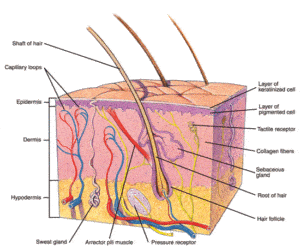
The three layers are:
- Epidermis or outermost layers
- Dermis or middle layer
- Subcutis or innermost layer
One major difference is that dogs produce multiple hairs out of a single follicle while humans and cats only produce a single hair shaft.
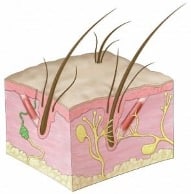
There are often significant differences in the skin of different species. Notable differences between canine and human skin are as follows:
| Canine | Human | |
| Epidermal layers | 3-5 | 10-15 |
| Epidermal cell turnover | Every 20 Days | Every 28 Days |
| Sweat glands | Foot Pads | Whole Body |
| pH of the skin | 7.5 Neutral | 5.5 Acidic |
Epidermis Layers
The epidermis is composed of older cells that form a tough, protective outer barrier that provides protection from foreign substances. As these outer cells slough off, other cells mature and move up to replace them. The epidermis is composed of multiple types of cells, including keratinocytes, melanocytes, Langerhans cells, and Merkel cells. Each of these cells have a special function. The epidermis varies in thickness. In the more exposed areas, such as the head and back, the epidermis is thicker than areas such as the belly and groin.
Keratinocytes provide a protective layer that is constantly being renewed in a process called keratinization. In this process, new skin cells are created near the base of the epidermis and migrate upwards. This produces a compact layer of dead cells on the skin surface. This layer keeps in fluids, salts, and nutrients, while keeping out infectious or noxious agents. The top layer of dead skin cells are continuously shed and replaced by cells from lower layers. The rate of cell replacement is affected by nutrition, hormones, tissue factors, immune cells in the skin, and genetics. Disease and inflammation also alter normal cell growth and keratinization.
Melanocytes are located at the base of the epidermis, the outer root sheath of hairs, and the ducts of the sebaceous and sweat glands. The melanocytes produce skin and hair coloring (pigment) called melanin. Production of melanin is controlled by both hormones and the genes received from parents. Melanin helps protect the cells from the damaging rays of the sun.
Langerhans cells are part of the immune system. These cells are damaged when exposed to excessive ultraviolet light and glucocorticoids (anti-inflammatory drugs). Langerhans cells play an important role in the skin’s response to foreign substances and contribute to such things as the development of rashes when an animal is exposed to irritating materials.
Merkel cells are specialized cells associated with the sensory organs in the skin. In particular, Merkel cells help provide animals with sensory information from whiskers and the deep skin areas called Tylotrich pads.
Basement Membrane Zone
This layer of the skin is located beneath the epidermis and connects the epidermis to the dermis layer below. It also serves as a protective barrier between the epidermis and the dermis. Several skin diseases, including a number of autoimmune conditions, can damage the basement membrane zone.
Dermis
The deeper layer (dermis) contains hair follicles, blood vessels, nerves and sebaceous glands that provide the skin with oils. The dermis supports and nourishes the epidermis and skin appendages. The blood vessels located in the dermis help regulate skin and body temperature also supply the epidermis with nutrients. Sensory nerves are also located in the dermis and hair follicles. This allows for the sensations of touch, pain, itching, heat, and cold. The dermis secretes the proteins collagen and elastin, which give support and elasticity to the skin. There are also immune cells in the dermis that defend against infectious agents that pass through the epidermis.
Subcutis or Hypodermis
The subcutis is the innermost layer of the skin. It contains subcutaneous fat and muscles. The word subcutaneous means “beneath the skin”. The subcutaneous fat provides insulation; a reservoir for fluids, electrolytes, and energy; and acts as a shock absorber.
Skin Appendages
Hair follicles, oil and sweat glands, and claws are skin appendages that grow out of the epidermis and dermis. Hair and nails are made of a hard substance called keratin.
Healthy Canine Hair Coats
The hair coats primary function is to protect the skin from physical and ultraviolet light damage. It is also helpful in the regulation of body temperature. It conserves heat by trapping dead air space between secondary hairs, which requires that the hairs be dry and waterproof. The cold-weather coat of many dogs is longer and finer to facilitate heat conservation. To facilitate cooling, the warm-weather coat has shorter, thicker hairs and fewer secondary hairs that allow air to move more easily through the coat. Scientifically, hair and fur are made of exactly the same material, a protein called keratin.
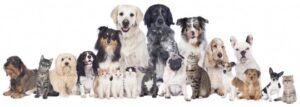
Puppies are born with simple hair follicles (one hair per follicle). They are covered by short, soft furry-like hair. Puppies have all the hair follicles it will ever have at birth. By six to eight months the hair follicles become compound (a central hair surrounded by 3 – 15 smaller secondary hairs all in the same follicle. At this time, the hair coat becomes a coarser, longer, and usually darker hair coat. Breeds and individuals have different rates of coat development. Factors such as day length, hormones, average outdoor temperature, and nutrition all influence coat development.
Hair growth in the dog occurs in cycles or phases. Phase I is called Anagen. This is when hair is produced. The new hair grows alongside the old, which is subsequently lost. Phase II is an intermediate stage called Catagen which signals the end of the growing phase. Phase III or Telogen is the resting phase where the follicle is considered dormant. The size, shape, and length of hair is controlled by genetics and hormones. Disease, drugs, nutrition, and environment can affect the health and growth cycles of hair coats.
Dogs have two types of hair. There are short fluffy hairs called secondary hairs, underfur or undercoat. The second type of hair is the longer and stiffer outer hairs called primary hairs, outer coat or guard hairs. The ratio of primary and secondary hair differs by breed and age.
There is no such thing as a non-shedding canine breed. The extent to which an individual dog sheds is governed by such factors as age, amount of sunlight, outside temperature, breed, sex, hormones, allergies and nutrition. Indoor dogs tend to shed in a more or less continuous fashion because of artificial heat and more importantly light. Outdoor dogs tend to shed for several weeks during major seasonal changes, most notably in spring and fall. They tend to grow more secondary hairs or underfur in the fall for warmth. In the spring they lose the underfur and replace much of it with longer primary or guard hairs. The hair coat changes in appearance and texture, but the absolute numbers of hair follicles and hair does not.
Oil & Sweat Glands
Oil glands (also called sebaceous glands) secrete an oily substance called sebum into the hair follicles and onto the skin. Oil glands are present in large numbers near the paws, back of the neck, rump, chin, and tail area. Sebum, a mixture of fatty acids, is important for keeping the skin soft, moist, and pliable. Sebum also gives the hair coat sheen and has antibiotic properties.
Dogs have sweat glands on the feet that may play a minor role in cooling of the body. Dogs primarily release excess body heat through panting and drooling.
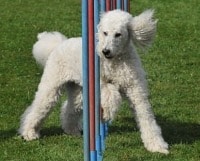
Continuously Growing Hair Coats
Most dogs grow their coat to a specific length and then the hair growth stops. In other breeds, the hair keeps growing. They may not appear to shed as much but, all dogs except for the hairless breeds shed. Breeds with continuously growing hair coats include:
- Bedlington Terrier
- Bichon Frise
- Irish Water Spaniel
- Kerry Blue Terrier
- Maltese Terrier
- Poodle
- Portuguese Water Dog
- Schnauzer
- Soft Coated Wheaton Terrier
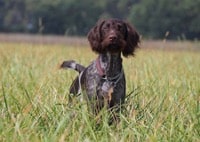
Wirehaired Coats
Wirehaired dogs have coarser textured hair that is more bristly than smooth. Many wirehaired dogs also have a characteristic beard. Most of the Terriers have this type of coat.
Curly Coats
Some breeds have curly coats based on their genotype. Straight hair is dominant over curly.
Breeds noted for their curly coats include:
- Airedale
- Irish Water Spaniel
- Curly Coated Retriever
- Poodle
- Welsh Terrier
- Wirehaired Fox Terrier
- Bichon Frise
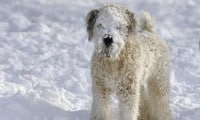
The following breeds can have either curly or straight hair based on their genotype:
- Havanese
- Kerry Blue Terrier
- Kuvasz
- Portuguese Water Dog
- Soft Coated Wheaten Terrier
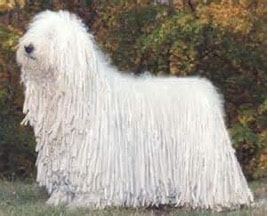
Corded Coats
Corded coats are both curly and continuously growing. The Puli and Komondor are examples of a breed with corded coats. This type of coat protects these herding breeds from wolves since the coat is so thick even wolf teeth cannot penetrate it.
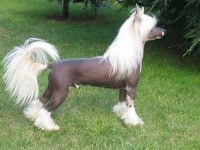
Hairless Breeds
A few breeds do not grow any hair at all like the Mexican hairless and American Hairless Terrier. One variety of the Chinese Crested grows hair on its extremities while another the Powder Puff has long hair covering its entire body.
Nutritional Ingredients & Healthy Skin & Hair Coats
The skin and hair coat must protect a pet against environmental insults, such as insects, bacteria, parasites and weather. Unfortunately, the skin and hair coat are on the bottom of the priority system when it comes to being provided the nutrients needed to remain healthy. Nutritional rationing always favors the internal organs. When a diet is poor in quality, fed in insufficient amounts or the demands of the dog exceed their nutritional intake, the skin & coat are the first to show signs of a deficiency. Perhaps this is why veterinarians see more skin and coat problems than anything else these days.
We all would like our pets to look like those show dogs we occasionally see on TV. Is there a reason most of our pets do not resemble our various breed champions?
One reason is that many of our pet foods still only provide maintenance levels of protein, fatty acids, vitamins and minerals. Owners of performance and show animals know the value of feeding higher quality diets and supplementing to achieve the desired effect.
When nutrient needs go up, such as we see during increased activity, performance, reproduction, injury, disease or stress…it becomes easier to see why the skin and hair coat of our pets can be so easily affected.
Some foods make our pets more susceptible to inflammation; something science tells us contributes greatly to disease.
Giving our pets more food just to provide additional skin and coat nutrients is not a good idea. More food – equals more calories – equals unnecessary weight gain. We all know about canine obesity numbers and the problems it presents.
Supplementation with the right product is actually a good solution. A high-quality Veterinary Health Supplement can provide specific skin and hair coat nutrients in a concentrated form that does not increase the daily caloric intake of the dog and cat.
It also makes sense that maintaining healthy skin & coat before problems occur would be easier and less expensive than trying to reverse the many skin and hair coat problems one can encounter.
Some common causes of skin problems include:
- Ringworm: This highly contagious fungal infection can result in inflammation, scaly patches, and hair loss. Lesions are most commonly seen on the head, ears, and paws, but sometimes signs are difficult to see. You’ll want to have a veterinarian examine and treat it immediately to prevent other pets and individuals in the household from becoming infected.
- Fleas: Not only do fleas irritate the skin, but dogs can also have an allergic response when exposed to them. Symptoms commonly include excessive scratching, thinning of hair above the base of the tail, crusts, and raised red skin lesions. Some dogs may also be sensitive to flea-treatment products. Some flea collars, for example, may cause redness and irritation around the neck.
- External parasites: Ear mites usually cause itching and redness around the ears and a dark, coffee ground-like material can be seen in the ear canals. Lice can produce intense itching, and mange mites can cause severe flaking and scaling.
- Abscesses: A painful collection of pus at the site of a bite or puncture wound. Abscesses form a firm swelling that becomes soft with time and can rupture spilling the purulent discharge.
- Food Allergy Dermatitis: Some dogs are extremely sensitive to certain ingredients or preservatives in their food. This sensitivity can result in severe itching over the head, neck and back, and swelling of the eyelids. It is often complicated by hair loss and oozing sores from constant scratching and biting. Treatment for this condition typically involves an elimination diet to see what ingredient(s) the dog is reacting to. Some veterinarians may give steroid shots to ease the swelling and itching and give the skin a chance to heal from any damage. Long term use of steroids should be avoided.
- Canine Acne: In this condition, comedones (also known as blackheads) form on the underside of the chin and edges of the lips. This condition may be associated with plastic or rubber food and water dishes. In severe cases, anti-seborrheic shampoos, such as those containing benzoyl peroxide (at a concentration of 3% or less), or benzoyl peroxide gels may be used to break down the excess oils. Supplementation with Omega-3 or Omega-6 fatty acids may be beneficial but check with a veterinarian first.
- Contact Dermatitis: Symptoms of this condition include red, itchy bumps and inflamed skin at the site of contact with some chemicals or irritants. The best way to prevent contact dermatitis is to keep dogs away from areas where chemicals are being used and to feed your dogs using glass, stainless steel, or lead-free ceramic dishes.
- Stud Tail: This is caused by glands near the tail that excrete excessive oils. The result is a greasy, rancid-smelling waxy brown material at the top of the tail near the base. This condition is most often found in un-neutered male dogs, but fixed males and females can get it, Treatment involves neutering if needed, and twice-daily washes with an anti-seborrheic shampoo to break down excess oils.
- Sunburn: Dogs with light-colored hair coats and hairless breeds can be prone to sunburn and should be kept out of direct sunlight between 10 a.m. and 2 p.m. to reduce the risk of sunburn and minimize the long-term risk of developing skin cancers such as melanoma.